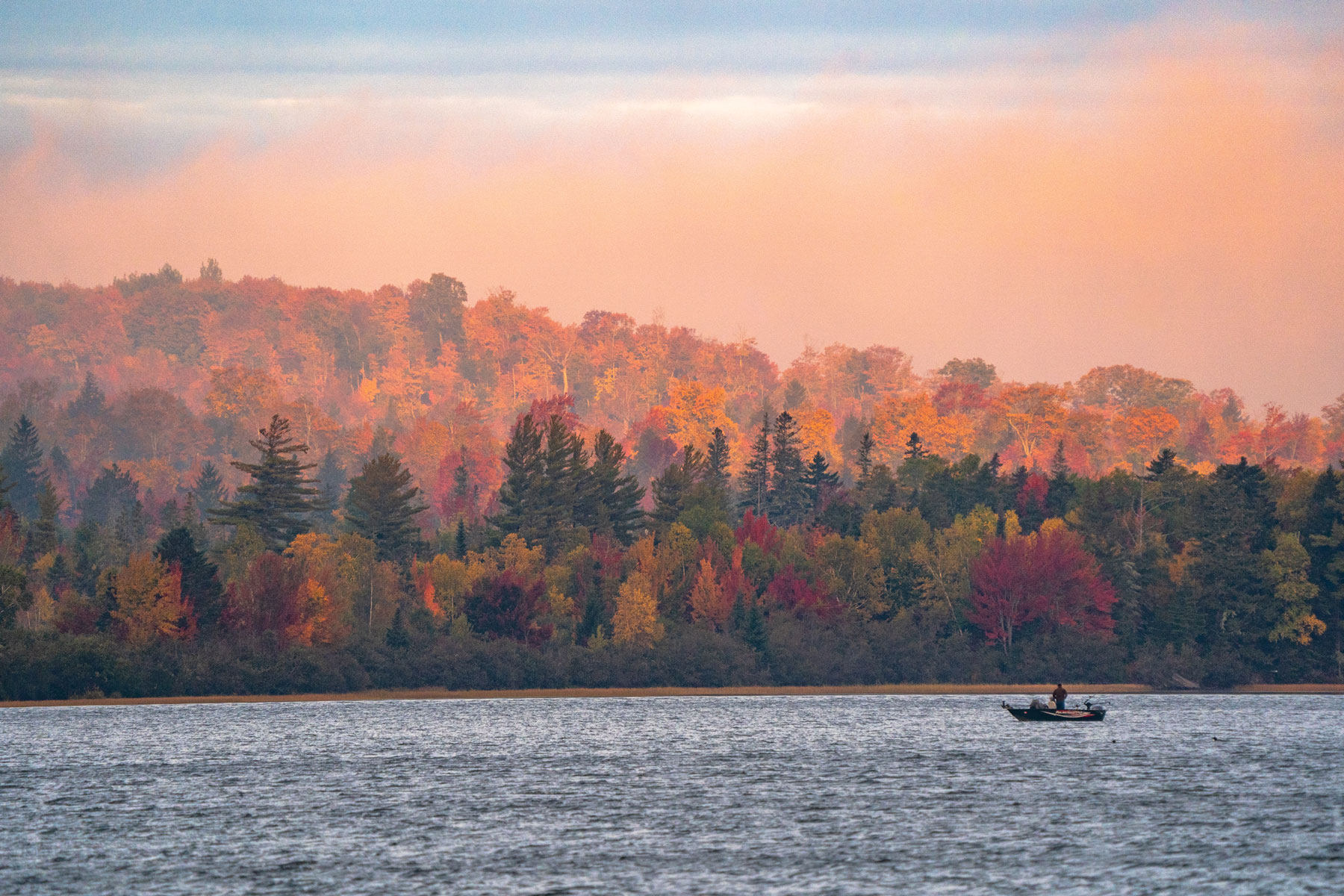By Virginia M. Wright
Photos by Benjamin Williamson
From our October 2021 issue
“There’s one!”
It’s early evening, the sun is low in the sky, and I’m gazing out the window of a floatplane, with bush pilot Josh Brown’s voice ringing tinny in my headset. Only seconds ago, he’d apologized for the scarcity of moose moving in the forest below us, but now he banks to the right and circles back toward a clear-cut, a brown-and-emerald tear in the dark fabric of trees billowing to the horizon. That’s what I’ve taken this flight to see: the uninterrupted 3.5-million-acre timberland that is Moosehead Lake’s backyard. A moose will be a bonus.
This forest has been logged and regrown many times since Henry David Thoreau immortalized it in the mid-19th century, but it retains much of the raw, unsettled spirit he described. “It’s all mossy and moosey,” he wrote. “At night, the general stillness is more impressive than any sound, but occasionally you hear the note of an owl farther or nearer in the woods, and if near a lake, the semi-human cry of the loons at their unearthly revels.”
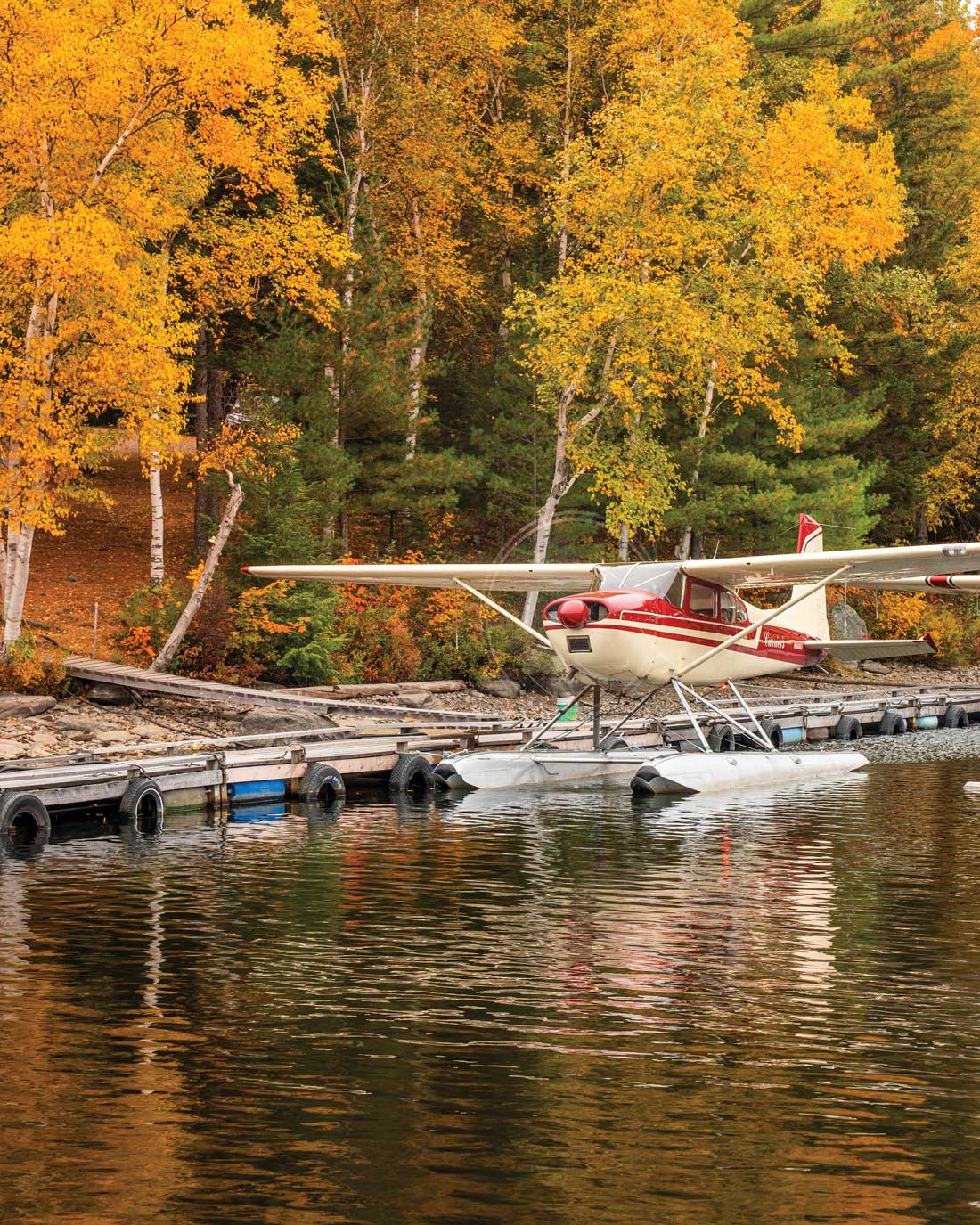
Even the lake, Maine’s largest at 118 square miles, feels untamed. Few houses are visible on Moosehead’s 400-mile shoreline or on the surrounding ridges and mountains. The exceptions are in Greenville, an unpretentious outpost of 1,600 people at the lake’s southern tip, and the sporting-camp village of Rockwood, 20 miles north along the western shore. Moosehead is an hour-long country drive from Interstate 95. Slim ribbons of pavement trace its western and eastern shores before turning away, one toward Jackman and the Quebec border, the other into the north woods, turning to dirt before joining the iconic Golden Road, a car-rocking loggers’ highway.
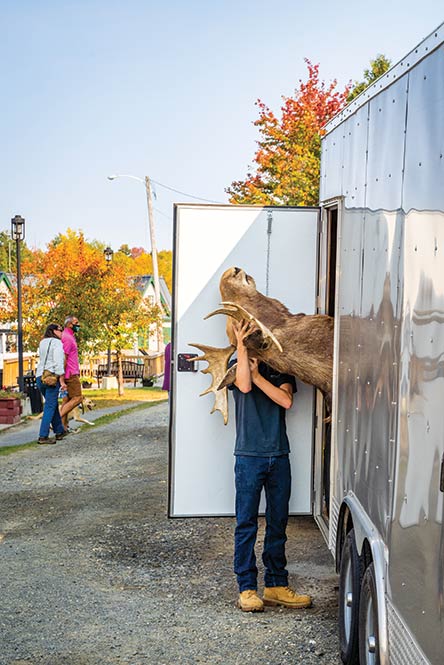
Brown is the pilot for Jack’s Air Service, a business founded 50 years ago by his late father-in-law, Jack Hofbauer, one of Moosehead’s bush-piloting legends. He keeps his plane — a four-passenger Cessna 120, white, with jaunty blue stripes along the fuselage and pontoons — on a downtown dock off Pritham Avenue, Greenville’s main drag. Besides scenic flights over Moosehead Lake, he offers transportation to secluded fishing ponds and cabins.
Brown is in the business of selling wilderness — as is nearly every working person in the Moosehead region, directly or indirectly, whether he or she is a Registered Maine Guide, an innkeeper, or a shop owner hawking mossy and moosey souvenirs. Moose-watching safaris are so popular here that when state wildlife officials proposed increasing the number of moose-hunting permits at a hearing in Greenville a few years ago, more than two dozen guides, outfitters, and business owners spoke against the plan (only two people spoke in favor). Not surprisingly, developments that would change the appearance of, or restrict access to, the natural surroundings are often met with wariness — or skepticism, since few of the projects floated in the last 20 years have come to fruition.
During my flight with Brown, I try to spot a few of their locations. To the lake’s southeast are the 75,000 acres that the Appalachian Mountain Club has acquired and conserved since 2003. Once controversial, the AMC’s stewardship has been embraced, largely because the group has encouraged recreation, renovated three old sporting lodges, and hired locals for construction and trail crews. In May, the AMC property was designated an International Dark Sky Park for its exceptionally starry skies. In making the announcement, the International Dark-Sky Association said the park sits within a vast, largely uninhabited forestland that “sees what may be the last remaining truly pristine night skies in the United States east of the Great Plains.”
West of the lake are Little Moose Mountain, near Greenville, and just behind it, Misery Ridge. Both high spots were eyed a few years ago for commercial wind farms that every local I’ve spoken with opposed. North of Little Moose is Big Moose Mountain, home to a 58-year-old ski area that a developer wants to expand into a resort with a hotel and marina and 500 condos and houses — a project that everyone I’ve spoken with supports.


Fly-fishermen throwing lines in the East Outlet of the Kennebec River.
We fly over Lily Bay, on the lake’s east side, where a few kayaks on the beach of Lily Bay State Park are the only sign of human presence. The peninsula next to the park was one of 10 areas on or near the lake that Plum Creek Timber Company designated for residential development in 2005. That proposal sparked a heated four-year debate and public outcry statewide. Around Moosehead, people were split. Some believed the two resorts and 2,000 vacation homes envisioned by Plum Creek would boost the local economy; others feared the loss of the region’s rugged, remote character. It turned out to be a moot point: by the time the state approved Plum Creek’s special zoning, in 2009, the housing market had crashed. Not a single house was built. Now, Lily Bay and the other former development areas are again the focus of a regional planning process that will guide what, if anything, may be built there in the future.
As the plane nears the clear-cut, Brown brings us down for a better look. Some people oppose cutting swathes of woodland down to stumps, he says, but wildlife is drawn to the grasses, wildflowers, and saplings that sprout in the sunlight. He can almost always count on a clear-cut to satisfy passengers eager to see moose. Sure enough, what appears to me at first to be a clump of stumps and branches sharpens into a cow moose munching on a tender young tree. At the rumble of the plane, the lanky beast raises her head. Then, unconcerned, she resumes her meal.

In the mid-’60s, when Eric Sherman was a tot, the noontime whistle at the Atlas Plywood Mill, in Greenville, was a call to entertainment. He’d stand on the curb outside his grandparents’ house and watch the stream of cars as workers headed home for lunch. An hour later, he’d be on the curb again as the cars paraded back to the mill. A fixture since 1890, Atlas employed about 350 people. Hundreds more worked in the logging industry, felling trees and towing enormous log booms across Moosehead Lake, some to Atlas and more to the East Outlet, from where the logs were driven down the Kennebec River. By the time Sherman was a teenager, Atlas had closed, the log drives had ended, and advanced machinery was shrinking the woodsmen workforce. Greenville’s population, which peaked at just over 2,000 in 1960, slid downward, leveling off at its current 1,600 residents in the 2010s.
It’s an older crowd — Greenville’s median age is 55, eleven years higher than Maine’s highest-in-the-nation state median. Enrollment at the K–12 public school hovers around 200, about half what it was 30 years ago, when Sherman started teaching seventh- and eighth-grade English. Most graduates move away, he says, because year-round jobs are hard to come by in an economy that depends so heavily on tourists and seasonal residents. To those students who want to stay, he points to Greenville’s 25-bed hospital and advises, “Do something in the medical field, because you can do that almost anywhere.”
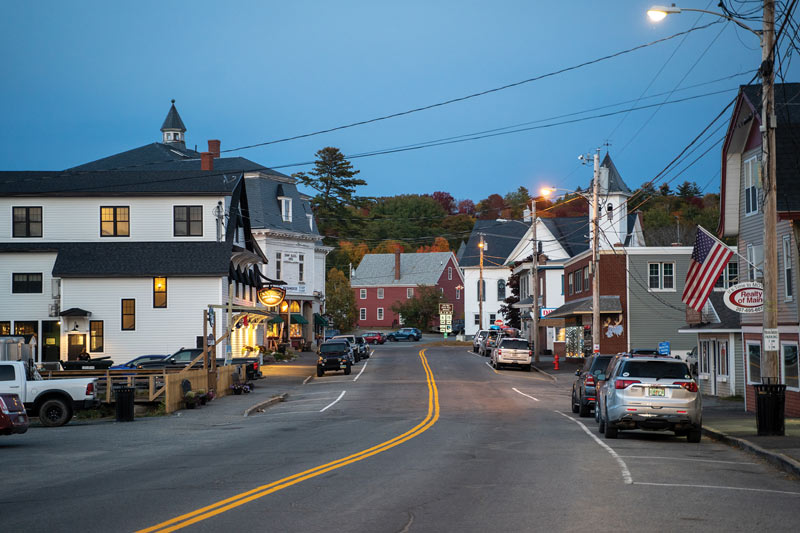
Relatively new is a housing shortage created by the “Airbnb effect” of investors converting houses to short-term rentals and by the COVID real-estate boom, fueled by urban refugees bidding up house prices. “Real estate is through the roof,” Sherman says. “Something goes on the market, and it’s gone in hours — and it’s not young families who are buying them. Year-round rentals are hard to find.”
Sherman tells me this while sitting in the café at Northwoods Outfitters. The downtown store is jam-packed with mountain bikes, kayaks, camping equipment, and other outdoor gear, and it offers a guiding service specializing in moose safaris, fishing trips, and kayaking and rafting tours. A rafting guide himself, Sherman has been active in the campaign to stop construction of a 145-mile Central Maine Power transmission line through the north woods and under the Kennebec Gorge, a popular whitewater destination. The corridor wouldn’t be visible from Moosehead, but he fears it will open the door to other projects that could spoil the region’s wild character, such as the long-debated East-West Highway, which would pass just south of Greenville, and mountain-top wind farms. There’s been no movement for four years on either the Little Moose Mountain or Misery Ridge proposals, but the town is still peppered with “Say No to Industrial Wind” signs.


Train tracks paralleling the road, which is part of the Moosehead Lake Scenic Byway; A ski chalet near the resort on Big Moose Mountain.
Balancing growth with landscape preservation is an ongoing challenge, Sherman says. “A few years ago, I visited Long Lake, in Naples. There wasn’t an inch of that lakeshore that wasn’t developed. It was house after house after house. I don’t want that for Moosehead. I recognize that without some growth, the school is in jeopardy, and without the school, Greenville would be a ghost town. The problem is, most of the people building here now are not living here. Their houses are empty more than half the year.”
In 2015, the Moosehead Lake Region Economic Development Corporation hired a community branding and marketing specialist to develop a plan for promoting the area as both a tourist destination and place to establish businesses and raise families. The corporation ended up branding Moosehead as “America’s Crown Jewel.” It has since been implementing the specialist’s other recommendations, creating things like a waterfront park in Greenville, directional signs to places of interest in the forest (like the wreckage of a B-52 bomber that crashed on Elephant Mountain in 1963), and business-relocation materials aimed at wilderness guides, photographers, and “adventure-seekers, artisans, and free spirits who want to live their passion while helping others find theirs.” The corporation is also pursuing development of a subdivision, with 20 affordable homes within walking distance of downtown. “No weekend rentals, no Airbnbs allowed,” corporation president Steve Levesque says.

Janet Chasse, a seventh-generation Greenvillian and former selectperson, participated in the branding initiative. What it overlooked, she believes, are the scores of independent crafters who need help selling their products. “So I decided to do it myself,” she says. She launched Moosehead Marketplace, an online store she operates out of her home. Its inventory of locally made wooden bowls, reed baskets, jigsaw puzzles, maple syrup, and other goods sells briskly, even though Chasse has done little marketing. Just having “Moosehead” in the shop name is a customer magnet, she says.
Still, like Sherman, she worries about the area’s lack of economic diversity. Her grown children have settled elsewhere. “They left for well-paying jobs,” she says. “Unless you come into a family business that you can take over, the only jobs are at the hospital or the school. The rest are, for the most part, seasonal. They don’t pay well, and they offer no benefits.”
The proposed expansion of the Big Moose Mountain ski area into a year-round retreat would ease the seasonal swings, she believes, but she has her doubts about the project’s viability. She doesn’t view Moosehead’s shores as off limits to other resorts — even around Lily Bay. “But my concern with the developments that have been pushed here is that young local families can very seldom buy into the market,” Chasse says. “They’re being priced out by second-home buyers.”

The Moosehead region has been handed a rare do-over in the management of Maine’s unorganized lands. Last year, the multinational timberland company Weyerhaeuser successfully petitioned the state for termination of the special zoning, or concept plan, created for Plum Creek’s Moosehead Lake lands in 2009. Weyerhaeuser merged with Plum Creek in 2015 to become the world’s largest timber and forest-products company, with 13 million acres in the U.S. As far as Weyerhaeuser execs are concerned, the development scenarios that Plum Creek envisioned are no longer realistic.
“Unfortunately, the impact of the 2008–2009 recession forever changed the United States development landscape,” senior land manager Luke Muzzy wrote in the petition submitted to the Land Use Planning Commission, Maine’s planning and zoning authority for its unorganized territories. Now, the 10 parcels formerly zoned for development — 16,873 acres in all — are on the table for rezoning. For now, at Weyerhaeuser’s request, they’ve been returned to their original land-use classification, which allows for sustainable timber management and, with LUPC approval, some development. But Weyerhaeuser has agreed not to clear-cut or pursue developments during community planning discussions. “We fully support this process and believe the people living and working in the region are best equipped to chart a future for the Moosehead community,” public affairs manager Chris Fife says.
With no resort proposals looming, interest in the rezoning effort has so far been high but not contentious. LUPC staffers began the public-input phase last winter, talking with local businesspeople, economic-development officials, and conservationists. An online survey drew 350 responses, mostly from year-round and seasonal residents, but also from non-local hikers, hunters, anglers, skiers, snowmobilers, and others who use the trails and waterways. “There was a broad range of opinions and viewpoints, but there was general agreement that the region is a beautiful and important place, that it’s worthy of special care and consideration,” LUPC senior planner Naomi Kirk-Lawler told commissioners at a virtual meeting in July.
Kirk-Lawler unveiled four mapped zoning scenarios for the former Plum Creek parcels, each offering different levels of development potential and conservation. They’re meant to be conversation starters, she says, rather than a fixed set of options to choose from. After gathering input at community meetings and online, Kirk-Lawler’s team will draft a land-use plan to be presented to commissioners next spring. Formal hearings will follow, and perhaps revisions, with the goal of adopting a final plan by the end of 2022.
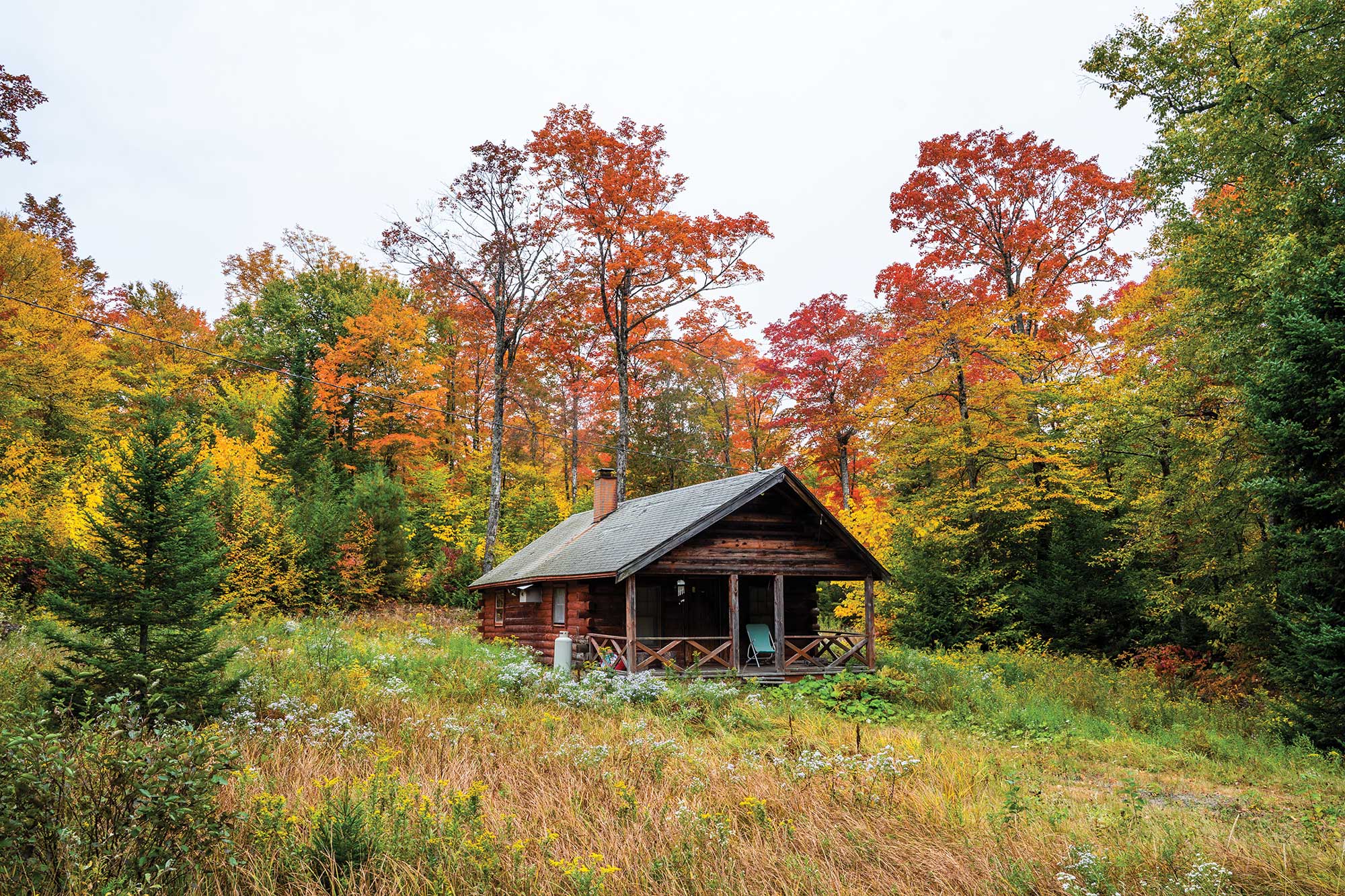
One often-repeated message among the survey responses: protect Lily Bay from development. That’s not surprising, as zoning around Lily Bay was the most hotly contested aspect of Plum Creek’s concept plan. Surrounded by conserved land and home to a smattering of camps, Lily Bay Township is known for offering solitude and sheltering abundant wildlife, including the Canada lynx, a threatened species under the U.S. Endangered Species Act. The concept plan would have permitted a resort with hundreds of houses, a marina, stores, and a golf course — “essentially a new town,” as former Natural Resources Council of Maine executive director Brownie Carson put it in 2008.
NRCM took the lead in opposing the Plum Creek plan and remains “strongly opposed” to development at Lily Bay, says Melanie Sturm, the organization’s forests and wildlife director. It’s also advocating for conservation measures on Blue Ridge, overlooking Rockwood; on Wilson Pond, east of Greenville; and on the west side of Big Moose Mountain, which borders long, narrow Indian Pond. “One of the unique things about the Moosehead region is how stunningly scenic it is,” Sturm says. “We want to preserve those views, so keeping the ridgelines and remote ponds free from development is important to us.” (The proposed ski-resort expansion, meanwhile, is not on the section of Big Moose that NRCM wants protected and is not part of the Weyerhaeuser rezoning project. “We’ve spoken with the developer, who says he wants infrastructure to fit seamlessly into the landscape. We feel they’re being thoughtful,” Sturm says.)


Looming over the lake’s northern reaches, Mount Kineo is reachable by a shuttle boat from Rockwood; Greenville’s Kamp Kamp spills onto the sidewalk.
NCRM supports new construction next to existing settlements, where roads, energy networks, and services already exist — an anti-sprawl priority that’s shared by the Moosehead Lake Region Economic Development Corporation. “Let’s concentrate development where there’s infrastructure,” corporation president Levesque says. Not that everyone agrees on what constitutes sprawl. Levesque, a Greenville resident whose credentials include directing the redevelopment of Brunswick Naval Air Station and a stint as a LUPC planner, says he was “pretty happy” with the final version of the Plum Creek concept plan. The Lily Bay subdivision would have been about 18 miles north of Greenville, the region’s service center.
The COVID real-estate boom will almost certainly play into the discussions, he adds. “We were looking at fairly slow growth, but COVID has changed the whole paradigm of working in rural communities. People are flocking to Maine because they believe it’s safer,” he says “That bodes well for the region, but there’s a carrying capacity to how fast we can grow and how much we can support.”

Jon Boynton was in eighth grade at Greenville Consolidated School when Plum Creek petitioned the state to rezone its land around Moosehead Lake, in 2005. “You know how some people go to college and study psychology because they want to figure themselves out?” Boynton says. “I did that to understand what I’d seen in our community: I studied geography and economics to become a planner.”
Boynton splits his week between Belfast, where he’s the city planner, and Greenville, where he has a home and serves on the planning board. I meet him and his partner, Chris Winstead, the Piscataquis County Economic Development Council’s former executive director, on Greenville’s waterfront boardwalk. Moored nearby is the Katahdin, the only survivor of Moosehead’s steamboat era. “Kate,” as she’s called, was built in 1914 to transport rusticators and sportsmen to camps and hotels around the lake. Later, she was put to work towing log booms. Now, she’s ferrying tourists again, offering narrated cruises to the cliff of 1,788-foot Mount Kineo.
The division over Plum Creek’s concept plan troubled the teenaged Boynton. “You had people who needed good jobs, and you had folks who saw only the downsides and were really vocal about it. It pulled us apart.” Looking back, he believes the plan’s potential impacts, both positive and negative, were exaggerated by inflamed passions.
The lesson, he says, is that a community needs to be proactive about defining the kind of growth it wants and where it wants it, instead of scurrying to respond to a developer’s plan or a phenomenon like a housing boom — but he’s not sure that lesson sank in. “We’ve thought about how people from away can spend a little longer time here,” he says, “and we’ve had consultants come in and tell us what is special about the region, but we’ve never come together as a community to identify what’s really important to us, what we need to protect and what we need to sell.”
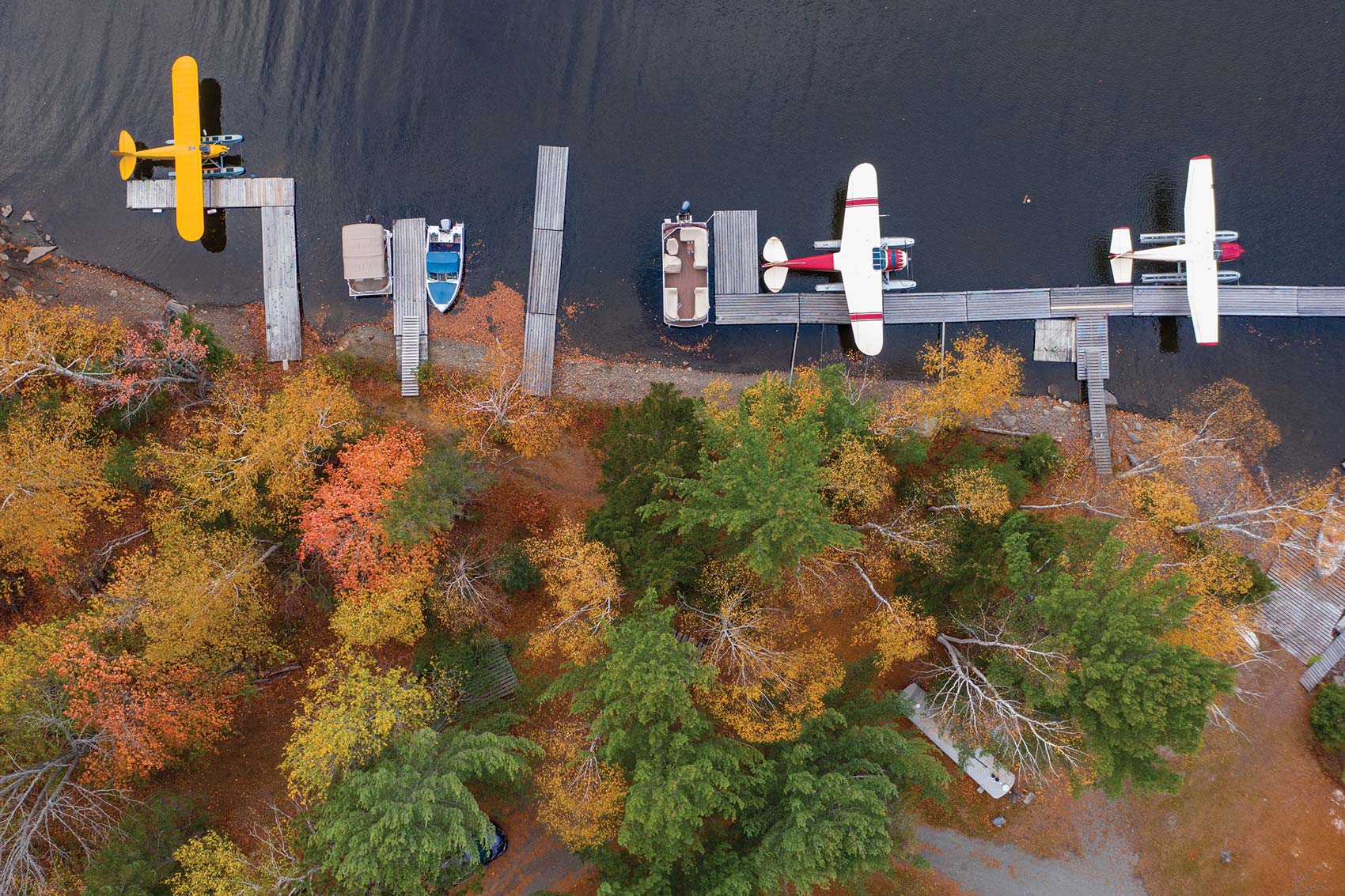
Boynton and Winstead often talk about how Moosehead Lake could be the next Jackson Hole if the community coalesced around a vision. “The challenge we’ve always had is balancing sense of place with the opportunities that are here,” Winstead says. “Too many people say, ‘I don’t want Greenville to change. I want it to stay the way it is.’ Well, if we don’t have change, those opportunities will eventually go away.”
Hours after talking with Boynton and Winstead, a little before sunset, I return to the Greenville waterfront to meet Josh Brown at the dock where he ties his seaplane. The aircraft skips lightly over the lake’s calm surface, and within seconds of becoming airborne, Greenville is behind us. “This is my favorite time to fly,” Brown says. “It’s like a nightcap — very relaxing.”
We spend about 30 minutes in the air, spotting our moose in the clear-cut. Then, before the flight ends, I see yet another moose. Brown points this one out shortly after we pass by Kineo. “I’ll show you how the lake got its name,” he says. “We have to be at just the right angle.” He tells me to look down in the direction of Greenville, and suddenly, I see it: the head of a big bull moose, its watery antlers spreading into Lily Bay and East and West coves, its long, blunt muzzle formed by Spencer Bay, even the bell dangling from its chin at Cowan Cove. A few seconds later, as we move southeastward over the lake, it’s gone.
